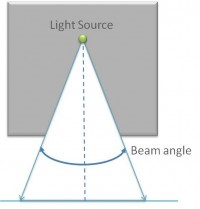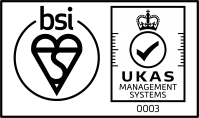There are many technical terms that cover the measurements and characteristics of light. Here’s a selection of the essential terms.
Beam Angle / Viewing Angle / FWHM

The LED beam angle, or LED viewing angle as it is also commonly referred, measures the usable light emitted from an LED source.
In most common situations, one of two methods is used to define the beam angle; the first looks for the angle at which 50% of the peak intensity is reached on either side of the origin. The second looks for the angle at which 10% of the peak intensity is reached on each side of the origin. Most commonly used is the Full Width, Half Maximum (FWHM) relating to 50% intensity, if for example an LED was measured to have 50% intensity at 15° it’s viewing angle (FWHM) would be 30°.
Luminous Flux (ΦV) – Lumens
Total amount of visible light emitted by a lamp. This corresponds to the total radiant flux of a lamp adjusted for the human eyes photopicsensitivity.
Luminous Intensity (IV) – Candela (or millicandela)
Luminous flux emitted per solid angle in a specified direction. Intensity is measured in units of lumens per steradian (lm/sr) or candela (Cd).
Illuminance (EV) – Lux
Illuminance is the luminous flux received at a surface per unit area. Illuminance varies with distance (inverse squared rule) and angle of illumination (Lamberts cosine rule). Illuminance is measured in units of lumens per square meter (lm/m2) or lux (lx).
Luminance (LV) – Nits
Luminance is the luminous flux emitted per solid angle per unit area – often referred to as brightness. Luminance is measured in the units of lumens per steradian per square meter (lm/sr.m2) or candela per square meter (Cd/m2), also known as nits.
Solid Angle (Ω)
A solid angle is the surface area of a sphere corresponding a specific beam angle. The unit of solid angle is the steradian.
Where, α = the full width angle in degrees
EMC, EMI and the importance of Electrical Safety
Electromagnetic Compatibility (EMC)
Electromagnetic Compatibility (EMC) has two fundamental goals:
The aim of EMC standards are not to achieve or guarantee absolute protection, e.g. zero emissions and total immunity. Attaining such performance would likely entail significant cost and impact upon the physical size and practicality of the end-product.
Electromagnetic Interference (EMI)
Electromagnetic interference (EMI) is defined as being disturbance that affects an electrical circuit via either electromagnetic induction or electromagnetic radiation emitted from an external source. The source may be any object, artificial or natural, that carries rapidly changing electrical currents, such as an electrical circuit, the Sun or the Northern Lights.
EMI has effects ranging from degradation of data through to total data loss in some electrical systems. Equipment that can be affected includes:
This list is not exhaustive.
Electrical Safety
Rules and regulations surrounding electrical safety have been developed by the EU to prevent the hazard of electrical shock in varying installation and operating conditions, the mandated standards take into account changing levels of humidity, temperate and atmospheric conditions in order to set the min required insulation distances between exposed live parts and other user accessible areas.
Smaller than mandated insulation distances can directly present shock hazards, but are also potential fire risks. If illegal product is installed into a publically accessible location and a fire results, it could be the case that insurance is invalidated and first call liability falls with the owner / operator for installing and using products which contravene EU safety directives.


